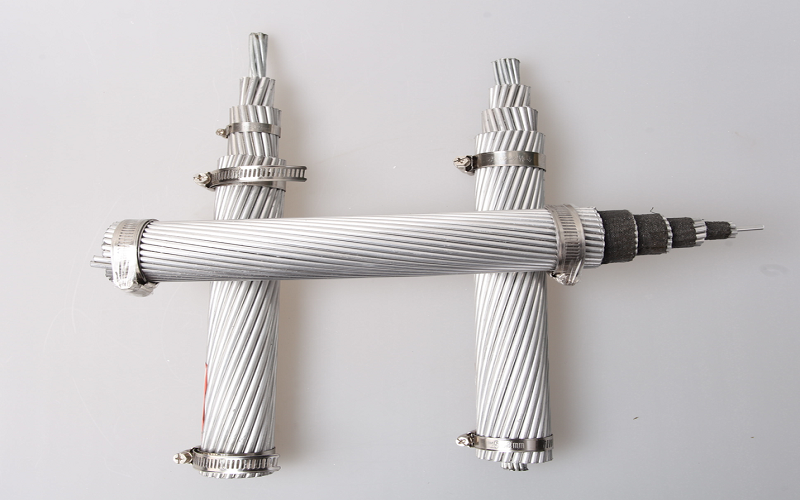

Faoi na hábhair tógála, Feicimid i gcónaí an cábla alúmanaim cóimhiotail uile(Cábla AAAC). Is é an táirge cábla is airde anois é. Mar sin, cad iad na buntáistí agus na míbhuntáistí a bhaineann le cábla AAAC?
Laghdaíonn an t -ábhar cóimhiotail agus an próiseas annálaithe den seoltóir cóimhiotail alúmanaim claonadh na sreinge go “creep” faoi theas agus faoi bhrú, agus feabhsaítear an fhriotaíocht creep ag 300% I gcomparáid le alúmanam íon, An fhadhb scíthe a sheachaint de bharr sreabhadh fuar nó creep.
I gcomparáid le seoltóirí alúmanaim íon, Tá feabhas mór ar neart teanntachta seoltóirí cóimhiotail alúmanaim. Mar gheall ar chomhpháirteanna speisialta agus teicnící próiseála speisialta a chur leis, méadaítear an ráta fadúcháin go 30%, atá níos sábháilte agus níos iontaofa le húsáid.
Tá naisc leictreacha cóimhiotail alúmanaim chomh sábháilte agus chomh cobhsaí le naisc sreinge copair. Comhdhéanamh an cóimhiotal alúmanaim Feabhsaíonn sé go mór a airíonna nasctha. Nuair a bhíonn an seoltóir annealed, Cruthaíonn an t-iarann breise friotaíocht creep ard-neart a chinntíonn cobhsaíocht an naisc fiú má tá an chomhpháirt ró-ualaithe agus róthéamh ar feadh tréimhsí fada ama.
Is féidir le cóimhiotal alúmanaim neart teanntachta alúmanaim íon a fheabhsú. Is féidir le cáblaí cóimhiotail alúmanaim seasamh in aghaidh 4,000 méadar de mheáchan féin. Agus ní féidir le cáblaí copair ach tacaíocht a thabhairt 2,750 méadar.
Is é is cúis le friotaíocht creimthe bunúsach alúmanaim ná ciseal ocsaíde tanaí agus láidir a fhoirmiú ar dhromchla alúmanaim nuair a thagann sé i dteagmháil leis an aer. Tá sé frithsheasmhach go háirithe i leith cineálacha éagsúla creimthe. Is féidir le alúmanam timpeallachtaí crua a sheasamh, Mar sin úsáidtear go forleathan é i dtráidirí seoltóra cábla, chomh maith le go leor comhpháirteanna agus coimeádán tionsclaíoch.
Is minic a bhaineann creimeadh le miotail neamhionanna a cheangal i dtimpeallachtaí fliucha, agus is féidir bearta cosanta cuí a dhéanamh chun creimeadh a chosc, mar bhealaithe, frithocsaídeoirí agus bratuithe cosanta.
Tá ithir alcaileach agus roinnt cineálacha timpeallachtaí ithreach aigéadach an -chreimneach le alúmanam, Mar sin ba chóir seoltóirí alúmanaim atá curtha go díreach a insliú nó a mhúnlú le truaill chun creimeadh a chosc. I dtimpeallachtaí ar nós tolláin iarnróid, Tá friotaíocht creimthe cóimhiotal alúmanaim i bhfad níos fearr ná copar.
Tá airíonna lúbthachta maithe ag an gcóimhiotal alúmanaim solúbtha. A chóimhiotal uathúil foirm. agus an teicneolaíocht próiseála a fheabhsú go mór an tsolúbthacht. Is é solúbthacht an chóimhiotail alúmanaim 30% níos airde ná an copar. Agus is é an ráta rebound 40% níos ísle ná an copar. Ansin an ga lúbthachta de copar Is é an cábla 10 × 20 uair, Cé nach bhfuil ach ga lúbthachta an chábla cóimhiotail alúmanaim amháin 7 amanna. Is furasta nascadh.
When people hear the term mineral insulated cable, many immediately think of harsh environments like…
As telecommunication networks and power transmission systems grow rapidly, the demand for reliable and cost-effective…
In large-scale oil and gas projects, industrial cables are not just accessories—they are the "nervous…
In the world of electrical connections, cable lugs—also known as cable ears or cable terminals—a bheidh…
When choosing the right rubber cable for an electrical engineering project, it is critical to…
Comhpháirtithe agus custaiméirí a chara: 29 Eanáir, 2025 Is í an Bhliain Nua Lunar na Síne – Spring…